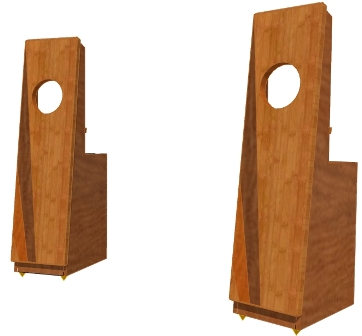|
There has been a peaked interest in Open Baffle Speaker designs on our Forums. Threads on the subject have remained active for well over year. Threads typically loose steam after only a few weeks or months so needless to say there is real interest in it. The first question in the minds of those of us who haven't owned or at least heard a pair is "Do they sound good, and if so - how?" Placing a speaker in a flat board rather than into a cabinet... On the one hand you have a di-polar speaker that puts out as much sound behind it as it does in front - usually good for imaging and sound stage depth. And of course no box to color the sound. On the other hand you have no box to prevent low frequency cancellation so no bass. It goes without saying that most open baffle designs have more than one speaker, the second one is often placed in a box to generate some tone and bass. Others are just simply large in size with one or more 15 inch woofers helping out a smaller driver. The larger cone area of a 15 inch woofer with the added boundary effect from the floor can create enough tone and bass extension to prevent the main speaker from sounding thin. In all cases it is a design challenge to get any real bass out of a speaker stuffed in a board. Unless the board is extra large the distance a sound wave would have to travel to get from the front of the cone and intercept the out of phase wave coming off the rear of the cone is too short to prevent cancellation much below 100 Hz. If you go with a small baffle so it won't take up your whole room and like your speakers to sound like they disappear then you can expect the figure to be even higher.
Like anything out of the ordinary, I find Open Baffle speakers intriguing. I've heard many over the years, most I thought sounded better than I expected and a few sounded worse. I see it as a battle between bass and imaging - to over simply it. I also notice in many designs the lack of texture or richness in the lower midrange that a well done cabinet either adds or preserves. I like to see things stay no more complicated than needed to achieve a goal when it comes to audio gear and speakers. Most Open Baffle guys are running at least two if not three or more speakers in their set ups. The main driver, a supplemental driver for more bass or tone, and a sub woofer. I see the fastest growing niche in the audio world as single driver full range crossover-less loudspeakers that can be driven with only a few watts. I would like to combine the huge interest in Open Baffle speakers with this niche. A single driver with no crossover means a single glorious point-source. My interest in Open Baffle design would be to preserve this purity. If you add a second larger driver in the baffle you have all kinds of complications to address. The phase angle at any given frequency will be different between the two drivers, that's problem number one. Both drivers can't occupy the same point in space, that's problem number two. Problem number three is how to drive two drivers rather than one. You either have to wire them together or use another amp, cables, crossover? Either option opens a Pandora's box of possible ways the coherency of a single point source could be damaged.
I would like an Open Baffle design that used a single 8 inch full range driver, and was small and sexy like a floor standing cabinet might be. I don't want a lot of cabinet or wide board to get in the way of imaging and the speakers ability to disappear. And I want it to have real tone and texture, like a well done cabinet. My guess is audiophiles who have ever built or designed an Open Baffle would ideally like the same things. It's almost like wishing for something out of nothing. This is no doubt why you don't see such an animal. Nevertheless it would like to get as close to achieving this goal as possible. Not only would I like it for myself, but I'd like to see the design (if successful) bridge the gap between the Open Baffle and Single Driver enthusiasts.
Over the years I've built a few Open Baffles. They ranged from sticking speakers in boards, to sticking speakers in slightly fancier boards. It was known going in that a sub would be used to help out the bottom. As a picky audiophile I observed that you can't help something out unless it is there to begin with. Even crossed over rather high around 120+ Hz there was a disjointedness to the sound. The subs always had a character all their own (usually pretty bad and each one different) that simply did not match the driver in the baffle. The problem was compounded when using tube gear to drive the baffle and solid state to drive the subwoofer. Anything that the main driver did well was poisoned by the non-matching driver, in this case, subs.
Don't get me wrong, the OB's I tried didn't sound hateful, but I've gotten more and more sensitive to harmonics as time passes and I'll have to explain where I'm coming from before you understand what I'm getting at. As someone who has run a small studio for the past 10 years that hosts an open stage on Thursday nights I stay very calibrated to what live instruments sound like. I'm also a drummer who's really picky about how the kit sounds and how it's tuned. I've recorded every single session and often use those masters to evaluate speakers or amplifiers. If you look at music, the thing that defines what you are listening to in all its subtle details is harmonics. The timbre of a given instrument would be impossible without the ultra complex harmonics that stem from fundamentals of each note. This is true anywhere in the audio band, and yes even if not especially in the bass. My kick drum is responsible for the heart beat in the music and most would perceive it as a bass note. However, while the fundamental tuning on the drum is typically around 40 Hz, every recorded beat from that drum contains harmonics and overtones clear up to 20 KHz. These harmonics are what make it sound real. They are how you can hear what type of beater head is being used on the pedals, and how you can hear differences in drum heads even if they're always tuned the same. It is why there are drum shells offered in Maple, Birch and a dozen other hardwoods - each gives the drum a different sound. So my point with all this, is that if you want an instrument to sound real when you play a good recording of it on your stereo, these harmonics should be viewed as being like DNA and preserved in any way possible. When you take the recording of the kick drum and reproduce part of it through one speaker and part of it through another speaker or system it will not sound like the real drum, only a recording of one. You've basically taken the DNA of that instruments sound and split it apart and tried to patch it back together. This is not unlike Jurassic Park where they didn't have all the pieces for the dinosaurs DNA so they used segments from a frog's DNA to make it work. To preserve the DNA a single driver with no crossover must reproduce the entire range of frequencies including the low frequencies.
RECENT ATTEMPTS You know it's hard enough to engineer something that actually works well, but as an artist I'm also cursed with making it considerably more difficult by insisting that it be pretty - or esthetically pleasing. In my world the artistic side challenges the engineering and drives the whole process. Engineering things has nothing to do with brilliance, it's just plain tedious work. Hard to get passionate about number crunching by itself but easy when the artistic background theme is involved. Well, getting back on track, I saw a truly attractive Open Baffle speaker recently. It had an 8 inch full range driver in it, but also had an attached cabinet with a 15 inch woofer inside. Staring at it I began to wonder if it would be possible to make a similar looking speaker without the supplemental 15 inch woofer inside (imagine that)! I pictured an empty cavity that resonated in concert with the 8 inch full range driver. The resonance of the cavity would achieve the tone and texture. But would it work?
Actually, integrating a horn mouth into this design really isn't an option. While possible, it would be too small in size to achieve any low bass. I am shooting for a goal of around 40Hz. A tiny horn flare that fits this profile would limit response below 100Hz. kind of defeating the purpose. HELMHOLTZ In this design the cavity must easily resonate when excited by a nearby speaker. I did a conceptual model on the computer ito determine what it would take to make this cavity resonate across two octaves. Specifically I was interested in how to couple the cavity to a tuned slot just below the back side of the speaker. This would involve creating a neck at the top of the cavity (like a coke bottle with respect to Helmholtz) and I needed to work through potential shapes. The formulas I found most helpful in determining the transmission loss characteristics of the neck, which would couple the cavity and driver were in a paper by Ahrnet Selamet and IIjae Lee from the Dept. of Mechanical Engineering and The Center for Automotive Research at Ohio State University The 2002 paper can be accessed at the Acoustical Society of America website and is recommended reading for anyone designing Helmholtz resonators for noise control or bass traps. In fact, one could say that if this worked, it was a bass trap added to an open baffle that created the bass. Hey, now we're getting into the Zen zone... Armed with some idea of how to design the neck, I did a conceptual sketch of it and then built a rough prototype from that sketch out of drywall to find out if this was even going to work. Here is a view of the drywall prototype with a modified FE206E installed.
FIRST ATTEMPT OBSERVATIONS The most fascinating part of this initial test was the slot itself. Closed and the whole cavity is deactivated, leaving you with a tiny completely bass-free open baffle for comparison sake. I found opening the slot took the hardness out of the midrange and the sound off the baffle. A massive improvement in midrange openness resulted... The other thing that came as no real shock was that the bottom of the cavity had to be vented slightly to increase the efficiency of the cavity resonance. (At least on this model it did.) Once the speaker was adjusted, I found the sound of it intoxicating. Not perfect, just doing several things better than I expected, thus intoxicating. I did notice during this time that some of the music had detectible bass that you could easily hear and feel. This was of course exciting, but other music that should have had bass was missing it. Since I hadn't even stuffed the cavity I expected a very narrow band typical of Helmholtz resonators. I just wanted to see how loud the resonance would be and if it would be enough. I expected it to drop a lot by the time I got the bandwidth wide enough to be usable. After a few days of casual listening and playing with it I decided to see what it was actually doing so I got the frequency generator out and started sweeping. Results of the test were expected but still rather horrifying. There was no detectible bass at 100Hz. In fact there was no bass at 50Hz. There was only bass at 80Hz. This was a good time for a long pause. I figured out that the widest Q that would still have enough output to be considered usable was still too narrow. It was starting to look like at least three resonators tuned 10Hz apart would be needed. This added level of complexity wasn't a terribly exciting option so with a bit more math I was able to talk myself out of it determining the dips between each peak would become noticeable only to some of us. I really needed the rubber throat effect of a good horn flare to get the smooth flat bandwidth I wanted but had already determined there wasn't enough space. To that end I pondered another day and then decided to meditate on it. I put the cabinet on its side and lay on the floor staring into the open bottom of the cavity. After two hours of this I felt like I understood the cavity. After all, the formulas I used for complex neck designs were basically how to change the tuning of a given cavity without changing its size. Regrettably, as usual, there were no formulas that could model the ideas I wanted to try next.
THE DESIGN THAT WORKS
While listening to the modifications it was a thrill to discover this actually worked perfectly. The cavity now resonates with a flat response across over an octave between 40 and 80 Hz. Unlike a ported speaker cabinet where the sound inside the cabinet is undesirable if you place your ear next to the port, this cavity sounds clear, not garbled, and contains exactly all of the musical information and low frequencies that are missing from the Open baffle part of the speaker. This in and of itself is rare and remarkable as far as I'm concerned. Part of the reason this is even possible is because the driver is not directly coupled to the cavity. There is no pressure exerted inside the cavity from the driver and the natural resonance of the cavity is at a very low amplitude leaving it distortion free when compared to speaker in a box that would cause the panels of the box to resonate (aka color/distort the sound). These results by themselves when compared to a simple open baffle of the same size are most impressive. The difference in midrange and overall imaging are remarkable. LIVE BROADCAST
Well obviously we can't stick our head down to the port to listen to the speaker so the most logical way to get the sound out of the box without increasing the pressure inside the box is to passively amplify it using a microphone feeding a second system. It might sound crazy, but provided the second system is done correctly, the purity of the design concept is preserved. The mic feeds a good quality microphone preamp that feeds an amplifier matching the one driving the Open Baffle. This second amplifier drives a second set of cabinets capable of reproducing low bass notes. The second system will allow you to tweak the low end in several ways ensuring you have as much or as little weight as you want at any given time. Why is this approach better or different than simply splitting the signal from your source into two separate systems? Read the part about harmonics again. Also understand that the second system is producing a live broadcast of the sound inside the cavity of the Open Baffle speaker.
If you see another paper on this in the future you'll know it was a success. Steve Deckert
More explanations of this overall concept were given in the forums and re-posted below:
I suppose whatís complex about how everyone else is doing it would be the result. Trying to get bass from a subwoofer and have it blend flawlessly with the driver in the open baffle isÖ complicated. Trying to fill a mid bass hole with a second woofer isÖ complicated. Trying to get the same imaging from a 15 as you would an 8 inch driver isÖ complicated. Harmonically handicapped might have been a better term. While this is no less complicated from a gear perspective it retains honest harmonic integrity by presenting the amplifier with a single crossover-less driver that completes the full bandwidth from top to bottom. All the bass, mid, treble you hear are being reproduced by that driver. The low frequencies are sampled naturally by a separate resonant cavity and have no negative effect on the driver unlike a box where the low frequencies are creating high pressures against the cone and coloring its sound. And unlike a driver applying high pressures and high frequencies to a box (modifying the wave fronts inside the box), coloring the sound in the box. (This is why sound inside a speaker box always sounds garbled). By separating the two, both the sound inside the cavity and the sound of the driver are uncolored. Getting the sound out of the cavity is where the live broadcast comes in. Using another set of speakers, a pair of mics and a good mic preamp allows us to hear the sound that is inside the cavity. Since this is mostly low frequencies we have to compare this approach with the conventional OB mated to a subwoofer, both fed from the same line level signal. In that approach, the subwoofer is reproducing the low frequencies from the recording. In this approach, the second speakers are broadcasting a live, pure analogue, direct feed from the cavity, not from the recording. Careful matching of components, ie., the mic preamp, and power amp and speakers for the broadcast will of course determine how much better this approach is, but I have already tried it with random mid grade components and it is still clearly working better than when we turned off the cavity (by closing the slot) and used a subwoofer. The bass sounds real on the broadcast setup, even with all solid state gear because I tried that too. The bass does not sound as real on the subwoofer setup. Besides the sheer strength of a live broadcast as a source vs. a CD player there is another big reason why this approach is proving better than closing the cavity and using a sub. Itís the cavity. The cavity gives the OB wonderful tone and timbre. Without it, there is, among other things, an obvious lacking of something in the mid bass region. Depending on how accurately you adjusted the level on the sub, a frequency response chart would show a shelf in the response with a nice hole in the center of it. Regarding the texture and tone from the cavity, itís clearly audible without the broadcast speakers. Iíll admit this whole thing is a bit of a mind twister. It's been keeping me on my toes and in the dark. Iím sure it will prove to be very interesting as it develops. Iím anxious to get the entire set up completed for some serious evaluation when Iíll be able to hear why this was a good or bad idea.
|
|
Decware is a trademark of High Fidelity Engineering
Co. |
 PREVIOUS ATTEMPTS
PREVIOUS ATTEMPTS Having done something remotely similar with the
design of the
Having done something remotely similar with the
design of the 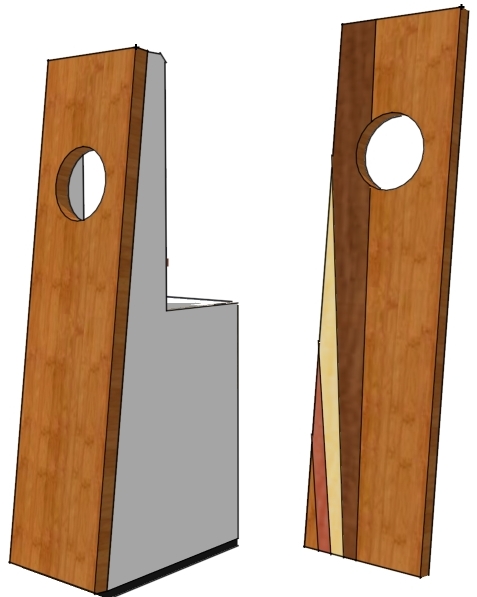
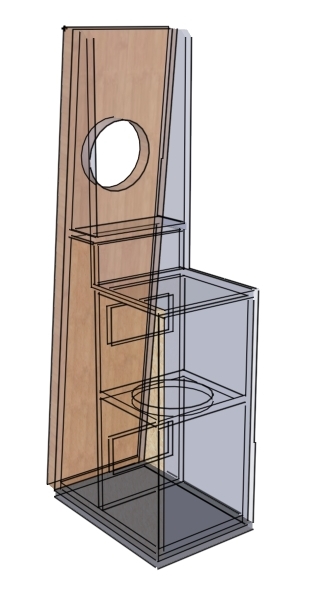
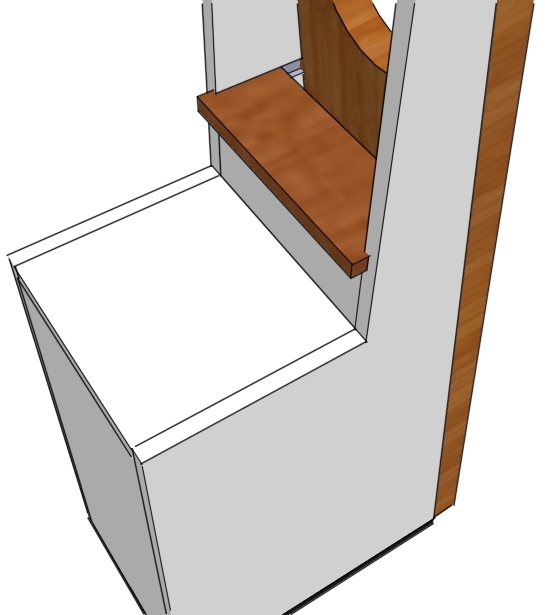
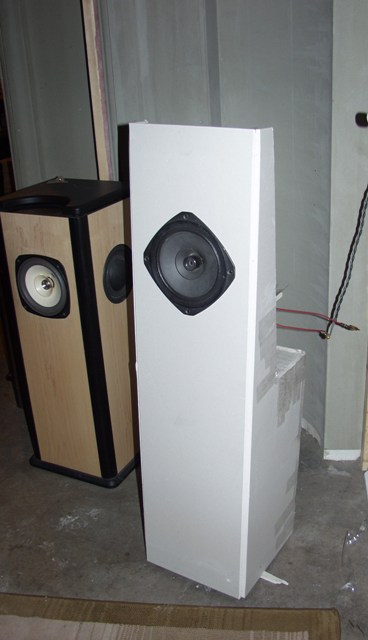

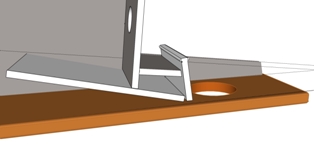 In another evening's modifications, I created a
In another evening's modifications, I created a
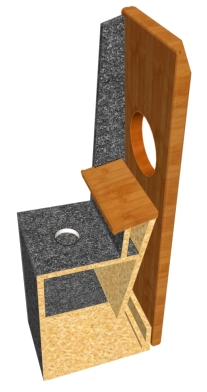 The final modifications included
sealing the bottom of the main cavity and putting a round 3/4"
long port at the top of the cavity to set the low frequency cut
off point.
The final modifications included
sealing the bottom of the main cavity and putting a round 3/4"
long port at the top of the cavity to set the low frequency cut
off point.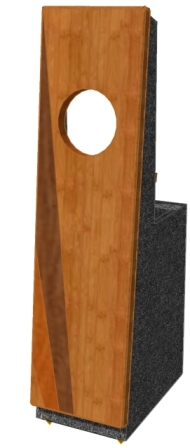 The final challenge is how to get the sound inside
this cavity to equal the same level as the sound coming from the
driver. If you listen to the port at the top of cavity with
one ear it places the back of the driver only 12 inches away from
your other ear. In this position the frequency balance is
simply outstanding, sounding like you're hearing a live gig. The
deep bass is wonderful.
The final challenge is how to get the sound inside
this cavity to equal the same level as the sound coming from the
driver. If you listen to the port at the top of cavity with
one ear it places the back of the driver only 12 inches away from
your other ear. In this position the frequency balance is
simply outstanding, sounding like you're hearing a live gig. The
deep bass is wonderful. As
this project progresses and if we decide to manufacture it, the
speakers would likely come with their own microphones pre-installed
in the proper way and a stereo microphone preamp. It will
be possible to get good results from supplying your own amplifier
and speakers for the live broadcast. We will develop the whole
system with matching electronics and synergistic broadcast cabinets
to evaluate the design in the best possible light. At this
stage of the game it becomes the next logical step.
As
this project progresses and if we decide to manufacture it, the
speakers would likely come with their own microphones pre-installed
in the proper way and a stereo microphone preamp. It will
be possible to get good results from supplying your own amplifier
and speakers for the live broadcast. We will develop the whole
system with matching electronics and synergistic broadcast cabinets
to evaluate the design in the best possible light. At this
stage of the game it becomes the next logical step.